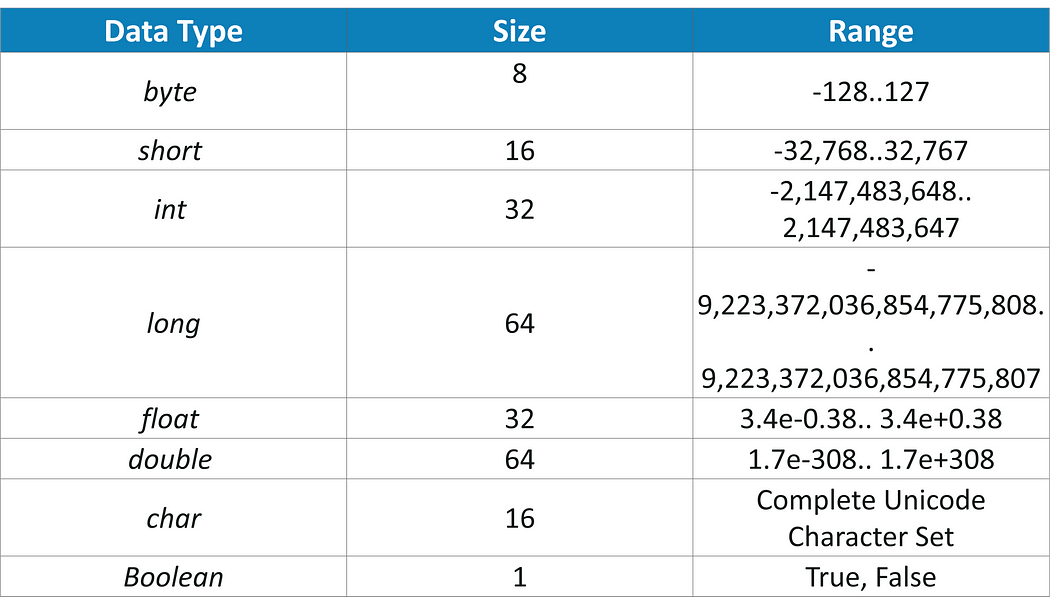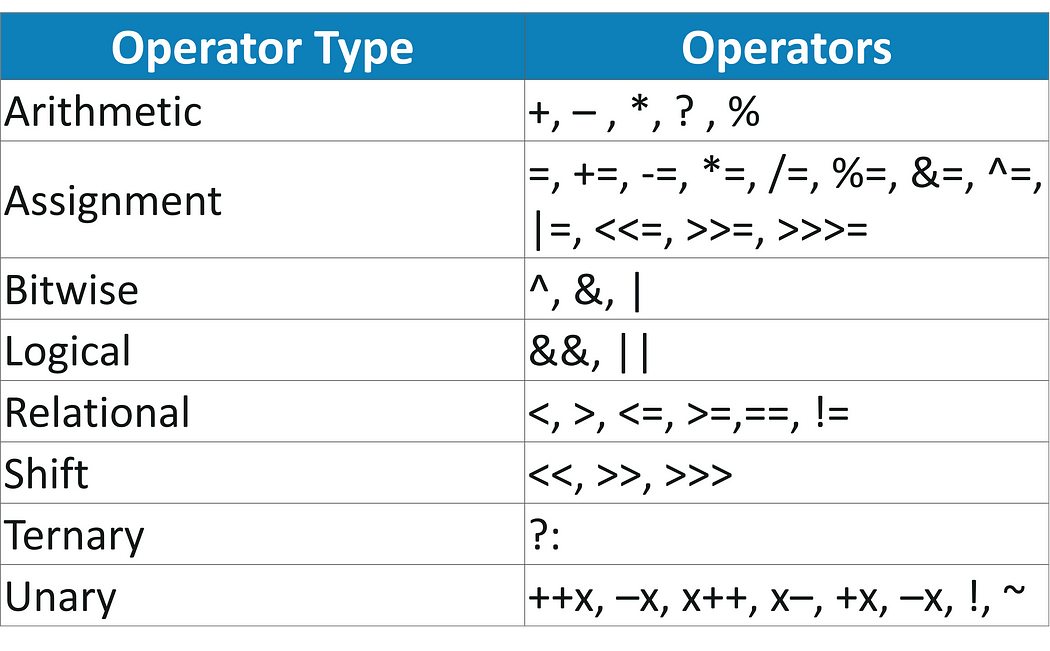CORE JAVA:
Are you hoping to become a Java developer? If you are, you can probably benefit from using this Java cheat sheet. Since Java is famous for its pre-built classes and libraries, keeping track of them can now and then be challenging. I am to provide you with the Java Programming Flow Chart now.
For Java beginners, this cheat sheet will serve as a crash course and assist you with various Java fundamentals.
Java Core Cheat Sheet

An open-source programming language called Java has been transforming the IT industry has a long history. Programmers strongly favor it because Java-written code can be safely executed on any platform, regardless of the operating system or device architecture. The setup of the JRE (Java Runtime Environment) on the system is the only basic requirement.
Primitive Data Types
Let’s start off by learning the primitive data types that Java offers:

Java Operators
There are mainly 8 different types of operators available in Java:

Java Variables
Variables in Java refers to the name of the reserved memory area. You need variables to store any value for the computational or reference purpose.
There are 3 types of variable in Java:
Local Variables
Instance Variables
Static Variables
{public | private} [static] type name [= expression | value];
Java Methods
A method is a set of code that is grouped together to perform a specific operation. A method is completed in two steps:
Method Initialization
Method Invocation
A method can be invoked either by calling it by reference or by value.
{public | private} [static] {type | void} name(arg1, ..., argN ){statements}
Conversion of Data
Data type conversion is the process of changing a value from one data type to another. There are two kinds of data type conversion:
Widening: Without sacrificing information, the smaller data type is changed into a larger one.
Narrowing: Information is lost when a larger data type is changed into a smaller one.
// Widening (byte<short<int<long<float<double)
int i = 10; //int--> long
long l = i; //automatic type conversion
// Narrowing
double d = 10.02;
long l = (long)d; //explicit type casting
// Numeric values to String
String str = String.valueOf(value);
// String to Numeric values
int i = Integer.parseInt(str);
double d = Double.parseDouble(str);
User Input
Java provides three ways to take input from the user/ console:
Using BufferReader class
Using Scanner class
Using the Console class
// Using BufferReader
BufferedReader reader = new BufferedReader(new InputStreamReader(System.in));
String name = reader.readLine();
// Using Scanner
Scanner in = new Scanner(System.in);
String s = in.nextLine();
int a = in.nextInt();
// Using Console
String name = System.console().readLine();
Basic Java Program
A basic program in Java will consist of at least the following components:
Classes & Objects
Methods
Variables
public class Demo{
public static void main(String[] args)
{ System.out.println("Hello from inayat!");}
}
Compile a Java Program
You need to save your Java Program by the name of the class containing main() method along with .java extension.
className.java
Call the compiler using javac command.
javac className
Finally, execute the program using the below code:
java className
Flow Of Control
Iterative Statements
Iterative statements are used when you need to repeat a set of statements until the condition for termination is not met.
// for loop
for (condition) {expression}
// for each loop
for (int i: someArray) {}
// while loop
while (condition) {expression}
// do while loop
do {expression} while(condition)
Decisive Statements
Selection statements used when you need to choose between alternative actions during execution of the program.
//if statement
if (condition) {expression}
//if-else statement
if (condition) {expression} else {expression}
//switch statement
switch (var)
{ case 1: expression; break; default: expression; break; }
Generating a Fibonacci series.
for (i = 1; i <= n; ++i)
{System.out.print(t1 + " + ");
int sum = t1 + t2;
t1 = t2;
t2 = sum;}
Checking the given number is prime or not.
if (n < 2) { return false; }
for (int i=2; i <= n/i; i++)
{if (n%i == 0) return false;}
return true;
Creating a pyramid pattern.
k = 2*n - 2;
for(i=0; i<n; i++)
{ for(j=0; j<k; j++){System.out.print(" ");}
k = k - 1;
for(j=0; j<=i; j++ ){System.out.print("* ");}
System.out.println(); }
Finding the factorial using recursion function.
int factorial(int n)
{
if (n == 0)
{return 1;}
else
{return(n * factorial(n-1));}
}
Java Arrays
Single Dimensional (1-D)
Single Dimensional or 1-D array is a type of linear array in which elements are stored in a continuous row.
// Initializing
type[] varName= new type[size];
// Declaring
type[] varName= new type[]{values1, value2,...};
Multi-Dimensional (2-D)
Two Dimensional or 2-D array is an array of an array where elements are stored in rows and columns.
// Initializing
datatype[][] varName = new dataType[row][col];
// Declaring
datatype[][] varName = {{value1, value2....},{value1, value2....}..};
Creating an array with random values.
double[] arr = new double[n];
for (int i=0; i<n; i++)
{a[i] = Math.random();}
Transposing a matrix.
for(i = 0; i < row; i++)
{ for(j = 0; j < column; j++)
{ System.out.print(array[i][j]+" "); }
System.out.println(" ");
}
Searching the max value in the array.
double max = 0;
for(int i=0; i<arr.length(); i++)
{ if(a[i] > max) max = a[i]; }
Multiplying two matrices.
for (i = 0; i < row1; i++)
{ for (j = 0; j < col2; j++)
{ for (k = 0; k < row2; k++)
{ sum = sum + first[i][k]*second[k][j]; }
multiply[i][j] = sum;
sum = 0;
}
}
Reversing an array.
for(int i=0; i<(arr.length())/2; i++)
{ double temp = a[i];
a[i] = a[n-1-i];
a[n-1-i] = temp;
}
Java Strings
Creating a String
String in Java is an object that represents a sequence of char values. A String can be created in two ways:
Using a literal
Using ‘new’ keyword
String str1 = “Welcome”; // Using literal
String str2 = new String(”Edureka”); // Using new keyword
The java.lang.String class implements Serializable, Comparable and CharSequence interfaces. Since the String object is immutable in nature Java provides two utility classes:
StringBuffer: It is a mutable class that is thread-safe and synchronized.
StringBuilder: It is a mutable class that is not thread-safe but is faster and is used in a single-threaded environment.
String Methods
Few of the most important and frequently used String methods are listed below:
str1==str2 //compares address;
String newStr = str1.equals(str2); //compares the values
String newStr = str1.equalsIgnoreCase() //compares the values ignoring the case
newStr = str1.length() //calculates length
newStr = str1.charAt(i) //extract i'th character
newStr = str1.toUpperCase() //returns string in ALL CAPS
newStr = str1.toLowerCase() //returns string in ALL LOWERvCASE
newStr = str1.replace(oldVal, newVal) //search and replace
newStr = str1.trim() //trims surrounding whitespace
newStr = str1.contains("value"); //check for the values
newStr = str1.toCharArray(); // convert String to character type array
newStr = str1.IsEmpty(); //Check for empty String
newStr = str1.endsWith(); //Checks if string ends with the given suffix






Comments
Post a Comment